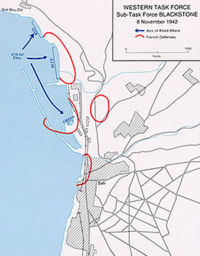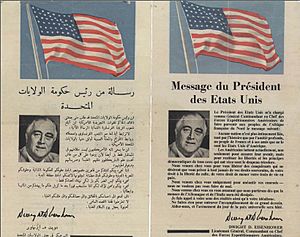Operation Blackstone facts for kids
Quick facts for kids Operation Blackstone |
|||||||
|---|---|---|---|---|---|---|---|
| Part of Operation Torch of the North African Campaign of World War II | |||||||
 A map showing landings during the operation |
|||||||
|
|||||||
| Belligerents | |||||||
|
|||||||
| Commanders and leaders | |||||||
| Strength | |||||||
| Ground forces: 6,400 troops Naval activity: 8 warships 6 transports |
Ground forces: 300 troops 3 tanks shore batteries and artillery pieces |
||||||
| Casualties and losses | |||||||
| US: 3 dead 25 wounded |
France: 300 troops captured |
||||||
Operation Blackstone was an important part of Operation Torch. This was a big plan by the Allied forces to land in North Africa during World War II. The main goal of Operation Blackstone was for American soldiers to land and capture the port of Safi. Safi was in French Morocco and was controlled by Vichy France at the time.
The 47th Infantry Regiment of the U.S. Army carried out these landings. They happened on the morning of November 8, 1942. This operation was part of a larger effort to capture the city of Casablanca.
The Landings at Safi
The American troops landed from ships that used to be destroyers. At first, they landed without any covering fire from their ships. They hoped the French forces would not fight back. But when French coastal guns started shooting, the American ships fired back.
When General Harmon arrived, French snipers were pinning down the American troops on the beaches. Many of these soldiers were in their first battle. Most of the landings happened later than planned. Airplanes from aircraft carriers helped by destroying a group of French trucks. These trucks were bringing more soldiers to defend Safi.
Safi officially surrendered on the afternoon of November 8. However, some fighting continued until November 10. By then, the remaining French defenders were surrounded. Most of General Harmon's troops then quickly moved north. They went to join the fight to capture Casablanca.
Why This Operation Was Important
This operation was part of a bigger plan called Operation Torch. Its main goal was to free North Africa from Nazi Germany's control. After France was defeated by Nazi Germany, parts of French North Africa came under German influence through Vichy France.
Operation Torch began on November 8, 1942. It helped free Algeria and Morocco from this control. Another important landing in Algeria was at Oran. Oran had two airfields, which were very useful for planes. Oran surrendered on November 9, 1942, just one day after the landings began.
American forces, led by Lloyd Fredendall, took Oran from the Vichy troops. Many Vichy soldiers actually supported the Allies. Taking control of Algeria was important for fighting the German Afrika Korps. It also allowed planes to fly from bases in South America.
After the Vichy French forces surrendered, there were talks between US General Mark W. Clark and French Admiral François Darlan. They met on November 10. These talks led to a ceasefire in Oran and Casablanca. The French army in Africa agreed to help the Allies fight the Nazis. They also agreed to help unload Allied supply ships and let the Allies use French trains.
See also
- US Naval Bases North Africa


